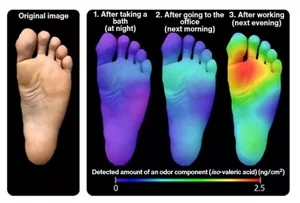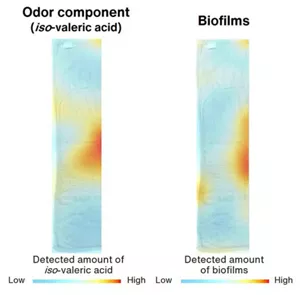ScentEYE - Technology that Visualizes Odors
Analysis Technology
Unpleasant odors displease us and pleasant ones give us comfort. It is said that there are hundreds of thousands of different substances that have some odor, with some components giving off an odor even if they are present in trace amounts. This is why we need to comprehensively and objectively analyze and evaluate trace amounts of odor components.
Kao developed new methods for collecting, concentrating and analyzing odors from different parts of an object and analyzing data on such odors, and created the ScentEYE technology. This technology now enables us to accurately visualize the types and amounts of odor components.
For example, we analyzed foot odors and found that the amount of iso-valeric acid, an unpleasant odor component, was almost the same between after taking a bath at night and after going to the office the next morning but significantly increased after working for a day. We also found that iso-valeric acid was present in larger amounts in some parts than others (Figure 1).

Figure 1 Foot sole odor
We also discovered that a towel collected from a normal household, and washed and then dried inside a laboratory had biofilms (masses of bacteria), and iso-valeric acid remained in larger amounts in the parts where more biofilms had accumulated (Figure 2).

Figure 2 Distributions of an unpleasant odor component and biofilms in a towel, visualized by the ScentEYE technology
The ScentEYE technology allows us to obtain accurate information on odors, such as when, where, and in what amounts odor components present in extremely trace amounts are volatilized (emitted into the air). We will continue to shed light on the nature of how unpleasant odors are generated and develop technologies for solving problems they present.
- Home
- Innovation
- Research & Development
- Fundamental Research
- Sensory Science
- ScentEYE - Technology that Visualizes Odors
- Home
- Innovation
- Research & Development
- Fundamental Research
- Sensory Science
- ScentEYE - Technology that Visualizes Odors
